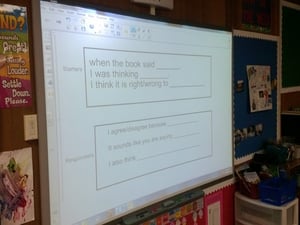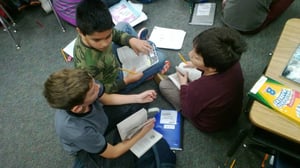The 5-Phases of Turn and Talk: How to Provide Support

"Collaboration provides the social glue that students need to become better readers," (Dewitz, 2022). Turn and talk during the instructional read-aloud increases collaboration and student engagement. But how do teachers support students who struggle with turn and talk? In this blog article, Sarah Collinge, author of the Read Side by Side Reading Program, walks you through the 5-phases of turn and talk and how to support students who are struggling.

Turn & Talk Structure (a quick review)
First, let's review how turn and talk is conducted in the Read Side by Side Reading Program.
1. Introduce the turn and talk stem.
Each lesson will introduce one turn and talk stem to be used by the teacher and students throughout the lesson. You will want to display this stem where all students can clearly see it.
Most teachers choose to use a pocket chart, white board, or screen. Some teachers provide a list of turn and talk stems for students to hold in their lap. No matter how you post the stems, be sure they are easily accessible for you and your students during the lesson.
Response stems should also be posted. Response stems will give students some choice. I suggest keeping response stems limited to 2-4 stems.
Question: Does your struggling student struggle to see the turn and talk stem?
⇒If so, consider seating the student closer to the turn and talk poster. Provide a copy of the stem for the student to hold in their lap.
2. Match students to a turn and talk partner/trio.
You will want to pre-determine who will be matched together for turn and talk. I suggest pairing two students who are fairly close in level , with one partner being slightly higher than the other. This type of partnership allows one partner to take the lead and model for the other student. Because the partners are fairly close in level, this difference in ability will be almost invisible to the students. The lower student will feel more confident to share their thinking and take a risk.
The first time you stop during the lesson, you will model your thinking using the turn and talk stem.
The second time you stop, you will ask students to turn and talk. The higher partner will share their thinking using the stem and the lower partner will listen and respond.
The second time you stop, the lower partner will now share their thinking using the stem and the higher partner will listen and respond.
Question: Is your struggling student well-match with a turn and talk partner?
⇒If not, consider changing who they are partnered with. Sometimes a student may appear to be struggling with turn and talk because they are uncomfortable in the partnership. You might also consider putting the student in a trio so they have the opportunity to hear more modeling from their peers.


The 5-Phases of Turn and Talk
The turn and talk routine in the Read Side by Side Reading Program requires students to:
1. Actively listen.
2. Respond to a partner: "I agree/disagree with you because..."
3. Share thinking: "When the book said _____, I was thinking..."
4. Provide evidence to support thinking: "because..."
5. Extend thinking: "This helps me understand..."
"When the book said _____, I was thinking _____ because _____.
This helps me understand _____."
Assess where students are in the 5-phases of turn and talk.
The 5-Phases of Turn and Talk - Download the PDF.
|
5-Phases: |
Looks / Sounds Like: |
0 - 4 |
|
Phase 1: Actively listen. The student actively listens when the teacher and/or peer models thinking. |
Phase 1 looks like:
|
0 No response. |
|
Phase 2: Respond to a partner. The student responds to the thinking of a partner. |
Phase 2 sounds like:
|
1 Limited Response |
|
Phase 3: Share thinking. The student shares thinking with a partner. |
Phase 3 sounds like:
|
2 Partial Response |
|
Phase 4: Provide evidence. The student provides evidence to support thinking. |
Phase 4 sounds like:
|
3 Complete Response |
|
Phase 5: Extend thinking. The student extends thinking to share how this helps them understand the book better. |
Phase 5 sounds like:
|
4 Extended Response |
*In phases 4 and 5 the student will begin to incorporate key vocabulary.
Provide support to students who struggle with turn and talk.
If your students are struggling to share their thinking using the stem, don't worry! With repeated modeling and repetitive practice, they will get it!
- Provide positive feedback and praise in each of the 5-phases of turn and talk: "I like the way you..."
- Explicitly state how the student can progress to the next phase:"Next time I'd like you to try..."

Concluding Thoughts
If you are new to the Read Side by Side Reading Program, this is the first time your students have been held accountable to this level of academic talk. It will take time for students to feel comfortable and confident with this new structure. The gradual release of responsibility will provide the scaffolding your students need as they move from modeling to shared practice, and guided practice to independence.
Keep modeling the use of stems, and prompting students to use them. You will see your students improve as you move into the 2nd and 3rd units. Eventually students will be successful as they talk with a partner, share thinking at the book club table, and will even begin using the stems in other subject areas! You'll wonder, How did I ever teach without them?
For more tools for assessing turn and talk including checklists and holistic rubrics, please visit the Assessment Page. I discuss turn and talk further in Chapter 1 of Raising the Standards and its accompanying videos.

Are you looking for a reading program to increase motivation and achievement?
We are confident the Read Side by Side Reading Program will be the right fit for your next curriculum adoption! To learn more about the program and request a sample kit, connect with one of our advisors!

Written by Sarah Collinge
Founder & President



